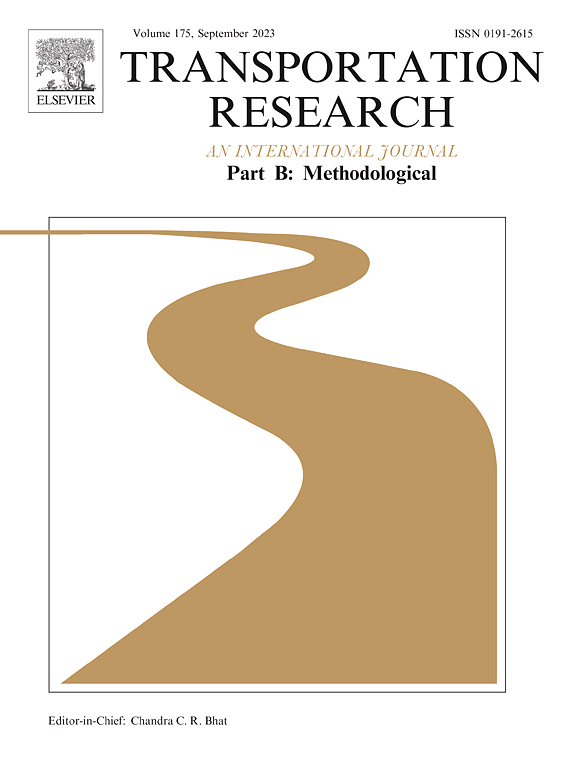具有多米诺骨牌风险的多车厢卡车和拖车加油站补给问题
IF 5.8
1区 工程技术
Q1 ECONOMICS
引用次数: 0
摘要
石油是石油工业和许多运输系统的基础。作为一种典型的危险品,用公路卡车运输石油产品会产生爆炸风险,对安全构成潜在威胁。要使汽油配送系统兼顾经济性和安全性,就需要设计完善的配送网络和有效的运输管理。本文提出了一个具有多米诺危险风险的新的多车厢卡车和拖车加油站补给问题,这是一个具有重大现实意义但研究关注有限的课题。该问题联合优化了油库和加油站的卡车路线调度、拖车路线调度和库存决策。明确考虑了汽油在运输、转移和库存过程中的蒸发效应。通过获取多源数据来构建加权社会因素,包括人口密度、GDP 产出强度、POI 密度和出行强度。应用多米诺骨牌效应和社会因素定制的综合风险评估模型,定量衡量储运过程中的相关风险。为解决这一复杂的非凸多目标问题,我们提出了一种问题分解策略,将原始主问题分解为两个子问题。结合多目标随机变量邻域下降搜索程序、归档多目标模拟退火和基于超立方体的选择机制的优点,我们开发了一种定制的多目标自适应大邻域搜索算法,用于解决与拖车相关的子问题。对于与卡车相关的子问题,采用了先进先出启发式和线性松弛法,并结合有效不等式快速计算上下限。这个综合的数学启发式框架有效地协调了两个子问题的解决方案。我们的模型被应用于中国广州大都市范围内的实际案例研究。研究结果凸显了配送成本最小化与社会风险最小化之间的权衡。卡车和拖车的可拆卸模式降低了运输成本,尤其是在配送网络扩大的情况下。拖车的车厢结构极大地影响了配送网络的效率。本文章由计算机程序翻译,如有差异,请以英文原文为准。
The multi-compartment truck and trailer petrol station replenishment problem with domino hazard risks
Petroleum is the foundation of the oil industry and many transportation systems. As a typical hazardous material, transportation of petroleum products by road trucks will create an explosion risk and pose a potential threat to safety. The petrol distribution system with economic viability and safety calls for a well-designed distribution network and effective transportation management. In this paper, we introduce a new multi-compartment truck and trailer petrol station replenishment problem with domino hazard risks, a topic of great practical significance but with limited research attention. The problem jointly optimizes truck routing-scheduling, trailer routing-scheduling, and inventory decisions for oil depots and petrol stations. The evaporation effects of petrol during the transportation, transfer, and inventory process are explicitly considered. Multi-source data are acquired to construct the weighted social factor, including population density, GDP output intensity, POI density, and travel intensity. The comprehensive risk assessment model tailored with the domino effect and social factor is applied to quantitatively measure the risks associated with storage and transportation processes. To tackle this complex non-convex multi-objective problem, we propose a problem decomposition strategy that decomposes the original master problem into two subproblems. A customized multi-objective adaptive large neighborhood search algorithm, combining the benefits of multi-objective random variable neighborhood descent search procedure, archived multi-objective simulated annealing, and hypercube-based selection mechanism, is developed to solve the trailer-related subproblem. For the truck-related subproblem, a first-in-first-out heuristic and a linear relaxation method combined with valid inequalities are employed to rapidly compute the upper and lower bounds. This integrated matheuristic framework effectively coordinates the solutions of the two subproblems. Our model is applied to a metropolitan-wide real-world case study in Guangzhou, China. The results highlight a trade-off between distribution cost minimization and social risk minimization. The detachable mode for trucks and trailers reduces transportation costs, particularly as the distribution network expands. The compartment structure of the trailer greatly affects the efficiency of the distribution network.
求助全文
通过发布文献求助,成功后即可免费获取论文全文。
去求助
来源期刊
CiteScore
12.40
自引率
8.80%
发文量
143
审稿时长
14.1 weeks
期刊介绍:
Transportation Research: Part B publishes papers on all methodological aspects of the subject, particularly those that require mathematical analysis. The general theme of the journal is the development and solution of problems that are adequately motivated to deal with important aspects of the design and/or analysis of transportation systems. Areas covered include: traffic flow; design and analysis of transportation networks; control and scheduling; optimization; queuing theory; logistics; supply chains; development and application of statistical, econometric and mathematical models to address transportation problems; cost models; pricing and/or investment; traveler or shipper behavior; cost-benefit methodologies.

 求助内容:
求助内容: 应助结果提醒方式:
应助结果提醒方式:


